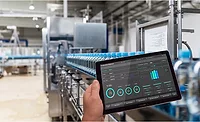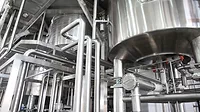Pros and Cons of Implementing Digitalization in the Food Packaging Industry

The food packaging industry is a multi-billion-dollar sector that ensures food safety and quality from farm to table. With digitalization disrupting traditional industries, its impact on food packaging is both profound and inevitable.
This article offers a nuanced look into how digitalization is reshaping the food packaging industry. Consider this your 101 guide to navigating the digital landscape.
The Rise of Digitalization in the Food Packaging Industry
We’ve moved past the days when food packaging was a manual, labor-intensive process. Automation brought about the first wave of transformation, increasing throughput and minimizing human error.
Now we're knee-deep into a second revolution—digitalization—which promises to redefine operational efficiency and customer engagement. Digitalization comes down to the application of digital tools to traditional food packaging processes, which is a fundamental change for the industry.
Digitalization involves the integration of digital technologies like the Internet of Things (IoT), artificial intelligence (AI) and blockchain into the very fabric of business operations. These technologies can solve real-world problems, from supply chain inefficiencies to compliance challenges.
The market is ripe for digital transformation. With increasing consumer demands for transparency and sustainability, not embracing digitalization is a risk too big to take.
Advantages of Digitalization in the Food Packaging Industry
Streamlined Operations
In the food packaging industry, time is of the essence. Digitalization allows for real-time monitoring of production lines. Smart sensors can detect temperature changes in food items, ensuring optimal conditions for storage and transport, which reduces spoilage and waste.
Digital platforms can also integrate with inventory management systems. This ensures that packaging materials get ordered and stocked just in time, reducing storage costs and improving cash flow. Since margins can be thin in this industry, these efficiencies can make a significant difference.
Improved Traceability
Food safety is paramount. Digital traceability tools can track the journey of a food item from the farm to the supermarket shelf. This level of detail is invaluable in case of a product recall and can help pinpoint the source of contamination faster than traditional methods.
Consumers are demanding more transparency from food suppliers than ever. Digital traceability can provide consumers with the information they want, right down to the farm of origin, thereby improving brand trust and loyalty.
Cost Savings
Energy costs are a significant concern in food packaging, especially for refrigerated and frozen items. Smart energy systems can monitor and adjust energy usage in real time, leading to substantial cost savings over time.
Predictive analytics can forecast demand, allowing for a more efficient use of resources. This means you can ramp up production ahead of high-demand periods, ensuring you meet customer needs while managing costs effectively.
Enhanced Customer Experience
Unboxing experiences often go viral nowadays. Digitalization facilitates personalized packaging, where each package can contain a QR code linking to personalized recipes or discounts on future purchases, enhancing customer engagement and loyalty.
Integrating augmented reality (AR) into packaging allows consumers to access additional product information or interactive experiences through their smartphones. This not only enriches the user experience but also creates new marketing opportunities for the brand.
Challenges and Considerations
Before diving headlong into the digital transformation journey, it's imperative to pause and consider the multifaceted challenges that come with it. Here are some potential hurdles to consider, along with actionable solutions, to help you make an informed decision:
- Initial investment: The upfront costs can be steep, covering both technology and staff training. Consider phased implementation and explore financing options.
- Complexity: Integration is not plug-and-play and requires a deep understanding of existing systems. Conduct a thorough system audit and consider hiring experts for seamless integration.
- Security concerns: The risk of data breaches increases with digitalization. Invest in robust cybersecurity measures and regularly update staff training.
- Ethical considerations: We cannot ignore Issues like job displacement and environmental impact. Develop a corporate social responsibility strategy that addresses these concerns.
- Data management: Handling vast amounts of data can be overwhelming. Invest in scalable data storage solutions and employ data scientists or analysts to make sense of the information.
- Regulatory compliance: The digital landscape is fraught with ever-changing regulations. Keep abreast of legal changes and consult with compliance experts to ensure you're always in line with the law.
Understanding these challenges is the first step in navigating the digital landscape effectively. The next step is action, but you should take action with a full understanding of the complexities involved so you can mitigate risks and capitalize on the opportunities that digitalization offers.
Navigating the Digital Landscape in the Food Packaging Industry
Strategic Planning
Strategic planning in the food packaging industry must consider both operational efficiency and regulatory compliance. Setting clear objectives around these pillars will guide your digital transformation journey. Without a well-defined strategy, you risk implementing technologies that don't solve your industry-specific challenges.
Stakeholder involvement is crucial, especially when it comes to compliance and quality assurance. Stakeholder insights can tailor the digital strategy to meet stringent food safety regulations, ensuring that your digital transformation improves rather than compromises product integrity.
Pilot programs in the food packaging industry can focus on a single production line or a specific product category. The insights gained can help you understand how digitalization impacts not just efficiency but also compliance and product quality, preparing you for a broader implementation.
Risk Mitigation
In this specific industry, risks can range from contamination to compliance lapses. A robust risk mitigation strategy must include regular audits of digital systems to ensure they meet food safety standards.
Learning from other sectors can be beneficial, but remember that the food packaging industry has its unique challenges, particularly around perishability and safety. Tailor your risk mitigation strategies to address these specific concerns.
Last, consider a dedicated risk management team that specializes in food safety and digital technologies. Their expertise can help navigate the complex regulatory landscape, ensuring that your digital transformation is both innovative and compliant.
Conclusion
Digitalization is a present-day necessity, especially in the food packaging industry. From streamlining operations to enhancing customer experience, the benefits are indispensable. However, the journey is not without its challenges, including the initial investment, complexity of integration, and concerns over food safety and regulatory compliance.
Balancing the allure of cutting-edge technologies with the responsibilities of compliance and ethical considerations is crucial. The roadmap to a successful digital factory must be rooted deeply in the industry's unique challenges and opportunities. It requires a proactive approach to risk mitigation, focusing not just on technological risks but also on the industry-specific risks related to food safety and quality.
The next step is action, but action that is calculated, informed and, above all, strategic. It doesn’t matter whether you're at the beginning of your digital transformation journey or looking to optimize existing digital systems—in a sector as critical as food packaging, being left behind is not an option.
Looking for a reprint of this article?
From high-res PDFs to custom plaques, order your copy today!









